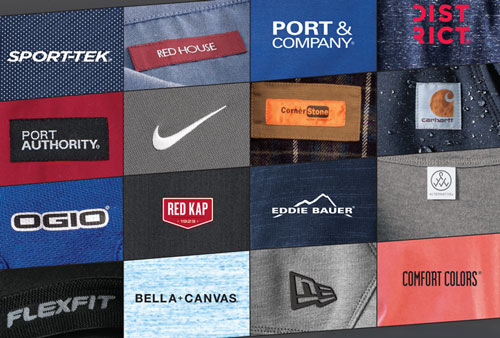How to Identify High-Quality Fabrics in Branded Clothing
How to Identify High-Quality Fabrics in Branded Clothing
Blog Article
The Importance of Sustainable Apparel: Just How It Affects the Setting and Your Closet
Sustainable apparel is increasingly identified for its crucial duty in lessening the environmental influence of the fast garment industry. By concentrating on green materials and ethical manufacturing methods, it attends to pushing ecological issues. This change not just profits the planet yet additionally affects consumer choices, causing a more thoughtful technique to closet monitoring. Recognizing these characteristics raises essential questions regarding fashion's future and personal obligation in shaping it.
The Environmental Impact of Rapid Style

Benefits of Sustainable Products
Lasting materials provide significant advantages, particularly with eco-friendly fabric choices that minimize ecological injury. These products additionally show resilience and longevity, reducing the demand for constant replacements. Therefore, they add to a much more sustainable garment industry and promote responsible consumer habits.
Eco-Friendly Textile Selections
While the style market has long been related to fast patterns and environmental injury, the increase of environment-friendly material choices offers a transformative chance. Sustainable products such as organic cotton, hemp, and Tencel have actually acquired appeal because of their lower eco-friendly effect. These fabrics are commonly generated without unsafe chemicals and call for less water, decreasing their carbon footprint - Branded Clothing. Additionally, several green fabrics are eco-friendly, adding to a round economic climate by reducing waste. Picking sustainable products not just supports ecologically liable practices yet also promotes much healthier communities. As customers come to be much more knowledgeable about their buying power, the need for eco-friendly fabrics motivates brands to innovate and take on even more lasting production methods, eventually benefiting the world and future generations
Sturdiness and Long Life Benefits
Numerous consumers are significantly recognizing the resilience and long life advantages of lasting products in their apparel selections. Unlike standard textiles, lasting products such as natural cotton, hemp, and recycled polyester are crafted to endure wear and tear, resulting in garments that last longer. This lowered frequency of substitute not only conserves customers cash gradually however additionally diminishes waste generated by quick fashion. On top of that, lasting apparel commonly utilizes environment-friendly production techniques that boost textile stamina, adding to a reduction in the overall carbon footprint. By spending in resilient garments, consumers can cultivate a much more sustainable closet while delighting in premium pieces that maintain their visual and performance over time. Longevity and durability stand as key advantages of choosing lasting products.
Decreasing Waste Through Sustainable Practices
Lowering waste in the apparel industry can be attained via ingenious practices such as upcycling and repurposing products. Furthermore, embracing minimalist wardrobe methods motivates consumers to focus on high quality over quantity, eventually reducing clothes usage. With each other, these approaches contribute considerably to a more lasting apparel design.
Upcycling and Repurposing Materials
Upcycling and repurposing materials have actually emerged as ingenious strategies in the garment industry, changing discarded fabrics into valuable new items. This approach not only decreases waste yet additionally encourages creative thinking and individuality in apparel layout. By taking old garments and products, developers can create one-of-a-kind pieces that reflect personal design while reducing the demand for brand-new resources. Furthermore, upcycling commonly requires less power and water contrasted to conventional production processes, substantially decreasing the ecological footprint of fashion. As consumers become more knowledgeable about sustainability, the appeal of upcycled garments remains to rise, promoting a round economy. Eventually, these methods add to a much more sustainable future, where style focuses on environmental wellness over rapid manufacturing and usage.

Minimalist Closet Methods
As people progressively look for to lessen their environmental influence, embracing minimalist closet methods has actually gained traction as an efficient method to sustainable style. These techniques stress quality over amount, encouraging consumers to curate a smaller sized collection of functional, resilient clothes. By concentrating on ageless pieces that can be combined and matched, individuals can lower the frequency of acquisitions and eventually reduce waste.Additionally, minimalism promotes conscious intake, urging buyers to assess the environmental and honest effects of their options. This strategy not just fosters a more sustainable way of life however likewise simplifies day-to-day decision-making regarding outfit. As people embrace minimalist principles, they contribute to a style society that values sustainability and accountable consumerism, inevitably leading to a more eco-conscious culture.
The Duty of Moral Labor in Lasting Style
While many consumers are progressively knowledgeable about the environmental repercussions of their garments options, the relevance of honest labor techniques in lasting fashion can not be neglected. Ethical labor encompasses reasonable incomes, safe working problems, and regard for workers' rights, forming the foundation of accountable fashion production. Brands that prioritize moral labor not just uplift communities yet likewise set a standard for responsibility in the industry.Moreover, the combination of ethical techniques promotes transparency, enabling customers to make educated choices regarding their acquisitions. This technique contrasts sharply with fast style's exploitative labor designs, which typically focus on profit over people. By sustaining companies committed to honest labor, customers contribute to a system that values human dignity together with ecological sustainability. As a result, moral labor is not merely an add-on; it is vital to the wider goal of sustainable style, making certain that the pursuit for eco-friendliness does not come at the cost of human civil liberties.
The Impact of Sustainable Clothing on Carbon Emissions
Sustainable clothing has the potential to greatly lower carbon emissions related to the style sector. Typical garment manufacturing contributes notably to greenhouse gas emissions, mainly because of energy-intensive manufacturing processes and using non-renewable sources. On the other hand, sustainable fashion concentrates on environment-friendly products, such as organic cotton or recycled fibers, which usually call for much less energy to produce.Moreover, lasting brands tend to embrace extra efficient manufacturing techniques, reducing waste and decreasing general exhausts. By prioritizing sturdiness and ageless design, lasting garments encourages customers to purchase much less often, further lowering the carbon footprint associated with overconsumption.Additionally, lots of sustainable brand names are committed to openness in their supply chains, enabling customers to make informed selections that line up with their worths. Eventually, shifting towards sustainable clothes can cause a substantial decrease in carbon emissions, adding to a much healthier planet and a more sustainable future for the fashion business.
Supporting Neighborhood Economic Climates With Lasting Choices
The change toward sustainable garments not just addresses environmental worries yet also significantly advantages local economic climates. By picking sustainable fashion, consumers often support little businesses and regional craftsmens, enhancing community strength. These enterprises commonly index operate a smaller range, prioritizing workmanship and moral techniques over mass production.Investing in locally made lasting apparel fosters task development and boosts economic growth within areas. As customers come to be more knowledgeable about the ecological impact of their acquisitions, they significantly choose items that show their worths. This demand motivates neighborhood manufacturers to adopt lasting techniques, adding to a circular economy.Moreover, sustaining regional businesses reduces transportation emissions, straightening with eco-conscious customer habits. The interconnectedness of sustainable clothing and neighborhood economies emphasizes the necessary function that private selections play in promoting both ecological and financial wellness. By fostering these local links, communities can grow while additionally working in the direction of a much more sustainable future.
Transforming Your Storage Room: Tips for a Lasting Wardrobe
As people seek to reduce their ecological impact, changing a closet right into a sustainable closet ends up being a crucial step. One reliable technique is to evaluate existing garments, maintaining only things that are used routinely which align with sustainability goals. Prioritizing high quality over amount is vital; spending in resilient items from environmentally friendly brand names can greatly minimize waste.Additionally, including pre-owned things can rejuvenate a wardrobe while decreasing environmental damage. Organizing garments swaps with friends or contributing extra products can even more promote sustainability.When purchasing, individuals should seek products that are organic, recycled, or eco-friendly, and prevent quick style stores - Branded Clothing. Practicing conscious intake by attentively considering each purchase can contribute to a more lasting way of living. By executing these suggestions, one can create a wardrobe that mirrors personal design while supporting environmental stewardship
Often Asked Questions
Exactly How Can I Determine Sustainable Clothes Brands?
To recognize lasting apparel brand names, one must investigate materials used, check for accreditations like Fair Trade, and take a look at the brand name's openness regarding their production procedures, labor techniques, and ecological impact, making sure honest and green methods are prioritized.
What Are the Prices Linked With Sustainable Fashion?
The prices connected with lasting style can vary considerably. Greater production expenses, honest sourcing, and environmentally friendly materials often result in raised market prices, which may hinder some consumers while interesting ecologically conscious buyers.
Can Lasting Garments Be Elegant and Trendy?
Sustainable apparel can undoubtedly be additional reading stylish and stylish. Developers increasingly focus on cutting-edge materials and moral manufacturing techniques, confirming that fashion and sustainability can exist side-by-side. Customers now have diverse alternatives that mix appearances with environmental consciousness.
Just How Does Laundering Clothes Affect Their Sustainability?
Washing clothing greatly impacts sustainability by consuming water and energy, adding to air pollution, and causing microplastic release. Regular cleaning can break down materials, reducing their lifespan and raising the demand for substitutes, inevitably intensifying environmental issues.
What Is the Life Expectancy of Lasting Clothing Contrasted to Rapid Style?
The life expectancy of sustainable clothes generally surpasses that of fast fashion products, often long-term several years because of high quality materials and workmanship. In comparison, rapid style garments might break down promptly, demanding even more regular replacements. Sustainable apparel is significantly acknowledged for its important function in decreasing the environmental influence of the rapid style sector. While several customers are progressively aware of the ecological effects of their garments options, the importance of ethical labor methods in lasting style can not be neglected. Branded Clothing. Sustainable clothes has the prospective to greatly lower carbon exhausts connected with the fashion sector. In contrast, lasting style focuses on eco-friendly products, such as organic cotton or recycled fibers, which often call for less power to produce.Moreover, lasting brands often tend to embrace extra effective manufacturing practices, lessening waste and lowering total emissions. By focusing on toughness and timeless layout, sustainable apparel motivates consumers to get less often, further minimizing the carbon footprint connected with overconsumption.Additionally, lots of sustainable brand have a peek at these guys names are committed to openness in their supply chains, allowing customers to make enlightened choices that line up with their worths
Report this page